Processing of Agricultural Products and Food
Quinoa and Oat Grain Beverage Production Project of Baicheng City
1 Introduction to the Project
1.1 Project background
1.1.1 Product introduction
Quinoa is one of the popular ancient grains in recent years, and is known as the “nutritional gold”, “super grain”, and “future food” by international nutritionists. Oats are a low calorie food that can easily cause a feeling of fullness after consumption, and are also recognized as a healthy food. Quinoa and oats both have the effects and functions of nutritional supplementation, energy supply, promoting digestion, maintaining blood sugar stability, and improving cardiovascular health. Quinoa oat cereal beverage is not only nutritious, but also has various health benefits, suitable for most people to consume, especially for those with gastrointestinal diseases, those who need to regulate blood sugar or protect cardiovascular and cerebrovascular health.
The project relies on the rich resource advantages of quinoa and oats in Zhenlai County to develop and produce quinoa oat cereal beverages. Quinoa oat cereal beverage has the characteristics of being “natural, green, nutritious, and healthy”, which is in line with the development trend of the beverage market and will be loved by a large number of consumers.
1.1.2 Market prospect
(1) Current situation of the grain food industry
Grain-based food, as an important source of energy for the human body, has always held a significant position in people’s dietary structure. In the Chinese Residents’ Balanced Diet Pagoda, staple food such as grains and miscellaneous grains is located at the bottom of the pagoda and is the foundation of the entire dietary structure. As early as in the Huang Di’s Inner Classic: Basic Questions, the principle of dietary regulation was proposed, which states that “five grains are for nourishment, five fruits are for assistance, five livestock are for benefit, five vegetables are for filling, and the aroma is suitable for consumption to supplement essence and qi”. At the same time, it also explains the dominant position of five grains and miscellaneous grains in diet. In recent years, the popularity of “whole grains”, “coarse grains”, and “whole grains” among consumers has highlighted the inherent health characteristics of cereal foods.
Many studies have shown that eating more whole grain food is beneficial to intestinal health, and can also reduce the risk of cardiovascular disease, obesity, type II diabetes, hypertension and all-cause mortality. Nowadays, traditional grains and ancient ingredients are making a comeback in the food and beverage industry. According to statistics and predictions from QYR Research, the global grain and food market size reached 43.145 billion US dollars in 2022, a year-on-year increase of 7.62%, and is expected to have reached 67.836 billion US dollars by 2029.
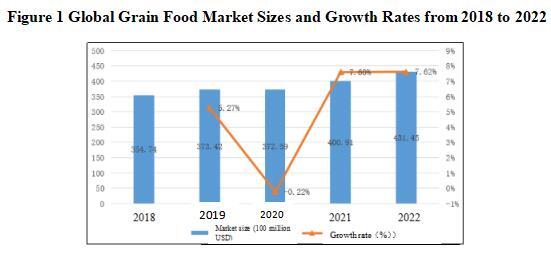
(2) Market situation of soft drinks
The market size of ready to drink soft drinks in China, divided by product categories, has been steadily increasing year by year, showing a growth trend. In 2018, the market size of ready to drink soft drinks in China reached 722.3 billion yuan; the period from the end of 2020 to the beginning of 2021 was the fastest year-on-year growth period for the industry, with a year-on-year growth rate of 8.48% in 2021; in 2023, the market size of ready to drink soft drinks in China reached 909.2 billion yuan, a year-on-year increase of 4.45%. The market size of ready to drink soft drinks in China reached 970 billion yuan by 2024.
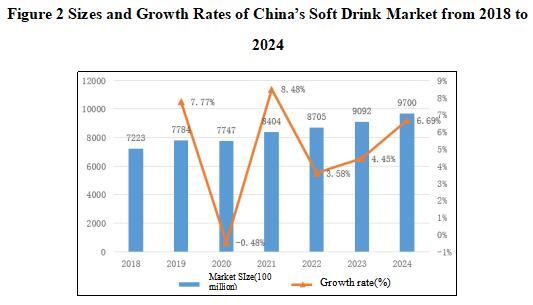
(3) Market analysis of the project
As a traditional Chinese diet, cereal has been one of the indispensable foods on the table for thousands of years and plays an important role in our diet. Grains mainly refer to the seeds of grasses in the family Poaceae. It includes rice, wheat, corn, and other miscellaneous grains such as corn, millet, black rice, buckwheat, oats, Job’s tears, sorghum, etc. Grains are processed into staple foods. It mainly provides humans with 50%~80% of thermal energy, 40%~70% of protein, and over 60% of vitamin B1.
Quinoa is a highly nutritious food crop. As an emerging fully nutritious functional health food, it contains abundant nutrients and active ingredients, and has high economic value. Quinoa contains all essential amino acids for the human body and is easily absorbed by the body. At the same time, quinoa is rich in vitamin B, vitamin C, vitamin E, minerals, as well as bioactive substances such as saponins, polysaccharides, flavonoids, etc., with outstanding nutritional value. Quinoa is one of the top ten nutritious foods globally recommended by the Food and Agriculture Organization of the United Nations.
Oats are a low sugar, high nutrient, and high-energy food. Oats have a sweet and smooth taste, which can benefit the spleen, nourish the heart, and reduce sweating. Oats are rich in dietary fiber, which can promote gastrointestinal peristalsis and facilitate bowel movements. Oats are recognized as functional foods with effects such as lowering cholesterol, stabilizing blood sugar, and maintaining metabolism.
Grains, as an important component of human daily diet, can provide most of the energy needed by the human body. Compared with other grains, quinoa oats are rich in protein, dietary fiber, and nutrients such as iron and zinc.
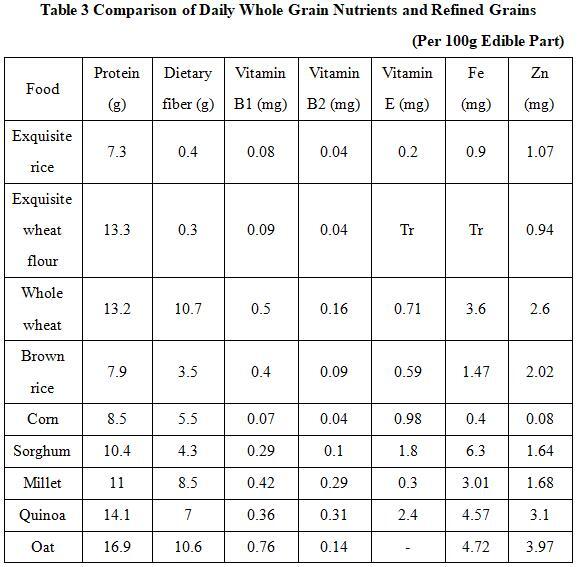
Note: It is quoted from the US Department of Agriculture database. Tr represents being below the detection limit of the currently used detection method or not detected.
The traditional dietary habit in China is mainly based on plant-based foods, among which cereal foods are the mainstay of the traditional Chinese diet. According to the Chinese Dietary Guidelines for Residents, carbohydrates account for 75-80% of the total amount in cereal food, proteins account for 8-10%, fats account for about 1%, and also contain minerals, B vitamins, and dietary fiber. With the development of the economy and the improvement of living standards, the proportion of animal based foods such as meat, eggs, and dairy in residents’ dietary structure is too high, while the intake of cereal foods is gradually decreasing. This dietary structure provides too much energy and fat, while dietary fiber is too low, resulting in a significant increase in “rich men’s diseases”. The food industry and consumers themselves are looking forward to the emergence of a more nutritionally balanced, safer, and more convenient food to improve the increasingly imbalanced dietary structure and enhance the nutritional and health level of the nation.
With the rise of the dietary culture of “grains and coarse grains” in China, the beverage market has sparked a green and healthy “grain beverage storm”. According to relevant data, with the improvement of living standards and the enhancement of health concepts, people’s demand for coarse grain beverages and healthy drinks is growing rapidly at a rate of 37%. In addition, in recent years, with the trend of plant-based beverages, grain based drinks have ushered in new growth opportunities. Therefore, the development of grain based beverages using grains and miscellaneous grains as raw materials will be a major direction for the future beverage market.
In the future, beverages will develop towards natural, nutritional, and health functional directions. Therefore, if grain beverages can choose pollution-free, even green and organic raw materials, and strengthen certain nutrients nutritionally, making them close to or even surpassing milk, soy milk, etc., it can be said that their development prospects are very good and they have great market potential. In addition, from the current market ranking of cereal beverages, it can be seen that consumers’ acceptance and love for cereal beverages are gradually increasing. At present, there are few grain beverage products in the domestic market. Grain beverages with certain novelty also have great appeal to contemporary young people who seek novelty and uniqueness.
With the improvement of health awareness, consumers’ demand for natural and healthy beverages is constantly increasing. Quinoa oat cereal beverages have the characteristics of rich nutrition and health, and the market prospect is good.
1.1.3 Technical analysis
The project adopts the modern production technology and automated production line, with the mature production process and technology, and has the conditions for large-scale production.
The production process of cereal beverages mainly includes steps such as raw material processing (soaking, rinsing, crushing), gelatinization, enzymatic hydrolysis, blending (or fermentation), homogenization, filling, sterilization, and cooling. According to different product types, it can be divided into blended grain beverages and fermented grain beverages.
1.1.4 Advantageous conditions of project construction
(1) Policy advantages
The Central Committee of the Communist Party of China and the State Council have issued the Healthy China 2030 Plan Outline, which proposes to formulate and implement a national nutrition plan, conduct in-depth research on the nutritional function evaluation of food (agricultural products, food), comprehensively popularize dietary nutrition knowledge, release dietary guidelines suitable for different population characteristics, guide residents to form scientific dietary habits, and promote the construction of a healthy eating culture.
In 2017, the Opinions on Deepening the Agricultural Supply side Structural Reform and Accelerating the Cultivation of New Kinetics for Agricultural and Rural Development, No. 1 Document of the Central Government proposed to build a food processing industry cluster in the advantageous agricultural product producing areas. Intensify support for technological transformation in the food processing industry and develop production and processing equipment with independent intellectual property rights. Encourage food companies to establish research and development institutions and develop new products that are suitable for the market around the “original brand name”. Strengthen the development and application of new food raw materials and food medicinal products.
15 other ministries, including the Ministry of Agriculture and Rural Affairs have issued the Notice on the Policy Measures to Promote the High-quality Development of Deep-processing of Agricultural Products, proposing the policy measures to promote the high-quality development of deep-processing of agricultural products. The notice proposes to promote the coordinated development of deep processing, initial processing, and comprehensive utilization processing of agricultural products, and to organically connect with upstream and downstream industries such as specialized raw material production, warehousing and logistics (including cold chain logistics), and market consumption. It should also be organically integrated and deeply integrated with rural industries such as nutrition and health, leisure tourism, education and culture, health and wellness, and e-commerce.
The Guiding Opinions on Cultivating Traditional Advantageous Food Production Areas and Local Characteristic Food Industries point out that building a base for characteristic beverage raw materials, promoting the promotion and application of modern food processing equipment such as fully automatic high-speed aseptic filling, intelligent temperature control cooking, CNC high-density fermentation, microwave sterilization, and ultra-high pressure non thermal sterilization.
(2) Resource advantages
Zhenlai County is located at 45。 north latitude, belonging to the mid temperate continental monsoon climate. It has long winters and summers, short spring and autumn, and a large temperature difference between day and night, providing the best growth environment for rice. The abundant sunshine of 2892 hours, effective accumulated temperature above 2800 degrees, and a golden growth cycle of 180 days provide the best growth environment for quinoa and oat cultivation.
Zhenlai County covers an area of 4718.69 square kilometers, with a total of 187300 hectares of arable land, 404.19 hectares of garden land, 40300 hectares of forest land, 41100 hectares of grassland, 13800 hectares of urban and industrial land, 9563.47 hectares of transportation land, 95200 hectares of water bodies and water conservancy facilities, and 84200 hectares of other land. It has adequate industrial and construction land.
(3) Industrial advantages
Zhenlai County is located at 45。 north latitude and has natural conditions suitable for crop growth. Zhenlai County relies on advantageous resources such as scientific research institutes and technology experts to continuously optimize the breeding of major grain crops such as rice, corn, and wheat, as well as livestock, poultry, fruits, and vegetables, update breeding management techniques, and gradually improve the yield and quality of agricultural products. Some key technologies for grain production, such as soil testing formula fertilization, mechanical deep loosening and land preparation, straw returning, integrated water and fertilizer, and comprehensive rice and crab breeding have been greatly improved. The comprehensive mechanization rate has reached 98%.
Zhenlai County implements the strategy of “storing grain in the ground and in technology”, comprehensively improving the efficiency and level of grain production through a combination of high-quality seeds, good methods, good techniques, and good fields. Under the dual promotion of policies and technology, the grain production in Zhenlai County has achieved significant growth and become an important national commodity grain production base. In 2023, the grain production in Zhenlai County will exceed 3.65 billion jin, achieving the “15 consecutive harvests”.
(4) Location advantages
Zhenlai County is located at the junction of the three major resource provinces (regions) of Heilongjiang, Jilin, and Inner Mongolia, and is known as the place “where rooster crowing can be heard in three provinces”. Within a radius of 200 kilometers, it is surrounded by five prefecture level cities (Songyuan, Baicheng, Qiqihar, Daqing, Ulanhot) and five regional airports, and is only 40 kilometers away from Baicheng Airport. There are two railways and two highways intersecting within the territory, making it an important “hub” city at the junction of Heilongjiang Province, Jilin Province, and Inner Mongolia. It is a must pass place for Inner Mongolia and Heilongjiang to enter the country, with convenient transportation and developed logistics, and has strong advantages in radiation and driving.
(5) Talent advantages
There are several research institutes in Baicheng City, including the Academy of Agricultural Sciences, the Academy of Forestry Sciences, the Agricultural Machinery Research Institute, the Livestock Research Institute, and the Research Institute. There are 40873 professional and technical personnel, including 6898 with senior professional titles, 18409 with intermediate professional titles, and 15566 with junior professional titles. Baicheng Academy of Agricultural Sciences is the only comprehensive agricultural research institution in the semi-arid special ecological zone of western Jilin Province. It leads the country in research on oats, sunflowers, miscellaneous grains and beans, and is the forefront and main research group for agricultural technology innovation and promotion in western Jilin Province.
1.2 Contents and scale of project construction
1.2.1 Product scale
After the project reaches its production capacity, it has an annual output of 200000 tons of quinoa oat cereal beverage.
1.2.2 Construction contents of the project
This project covers an area of 100000 square meters and has a building area of 80000 square meters. It will construct the production and processing workshop, raw material warehouse, finished product warehouse, packaging materials and miscellaneous goods warehouse, comprehensive office building, purchase the production equipment, and build supporting facilities such as water, electricity, heating, ground hardening, and greening.
1.3 Total investment of the project and capital raising
1.3.1 Total investment of the project
The total investment of the project is 400 million yuan, including the construction investment of 320 million yuan and current funds of 80 million yuan.
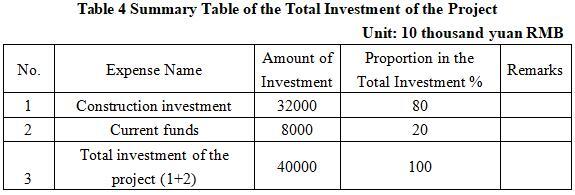
1.3.2 Capital raising
Self-financing by the enterprise
1.4 Financial analysis and social evaluation
1.4.1 Main financial indexes
After the project reaches the production capacity, its annual sales revenue will be 1.2 billion yuan, its profit will be 150 million yuan, its investment payback period will be 4.7 years (after the tax, including the construction period of 2 years) and its return on investment will be 37.5%.
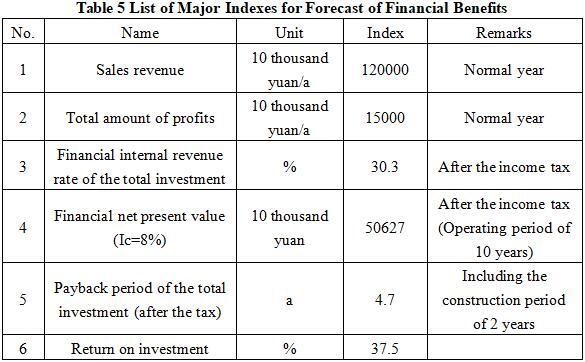
Note: “10 thousand yuan” in the table is in RMB.
1.4.2 Social evaluation
The production of quinoa oat cereal beverage in the project not only meets consumers’ demand for healthy eating, promotes innovation and development in the food and beverage market, inherits and promotes healthy eating culture, improves public health and quality of life, but also promotes the upgrading of the agricultural industry chain, increases the added value of grains, and brings significant economic and social benefits.
1.5 Cooperative way
Sole proprietorship or joint venture
1.6 What to be invested by the foreign party
Funds, equipment or technology
1.7 Construction site of the project
Zhenlai County, Baicheng City
1.8 Progress of the project
The project proposal has been prepared.
2 Introduction to the Partner
2.1 Basic information
Name: Zhenlai Project Development Service Center
Address: 1777 Xinxing South Street, Zhenlai Town, Zhenlai County, Baicheng City
2.2 Overview
Zhenlai County is located in the northwest of Jilin Province, at the junction of Jilin Province, Heilongjiang Province, and Inner Mongolia, and is a convergence zone of the Songnen Plain and the Horqin Grassland. To the east is the Nenjiang River, facing Duerbote Mongolian Autonomous County and Zhaoyuan County in Heilongjiang Province across the river, to the west is Ulanhot City in Inner Mongolia Autonomous Region, to the north is Tailai County in Heilongjiang Province and Zhalaite Banner in Inner Mongolia Autonomous Region, and to the southwest and south are adjacent to Baicheng City, Da’an City, and Taobei District respectively. Zhenlai County is a large-scale commodity grain base and livestock development demonstration base in China. The location and transportation advantages of Zhenlai County are obvious, with Zhenlai County as the center and a radius of 500 kilometers, which can comprehensively cover industrial cities and resource rich areas in the northeast region.
In 2023, the county’s GDP reached 9.48 billion yuan, a year-on-year increase of 6.6%; the fixed assets investment reached 2 billion yuan, up 23.6% year on year; the total output value of industrial enterprises above the designated size reached 2.7 billion yuan, a year-on-year increase of 9%; the added value of industrial enterprises above the designated size reached 780 million yuan, a year-on-year increase of 7%; the total retail sales of consumer goods reached 1.42 billion yuan, a year-on-year increase of 7%; the local level fiscal revenue reached 400 million yuan, a year-on-year increase of 20%; the per capita disposable income of urban residents increased by 8% year-on-year; the per capita disposable income of rural residents increased by 9% year-on-year.
2.3 Contact method
2.3.1 Contact method
Contact unit: Zhenlai Project Development Service Center
Contact person: Tian Tian
Tel: +86-15886168765
2.3.2 Contact method of the city (prefecture) where the project is located
Contact unit: Baicheng Bureau of Commerce
Contact person: Xu Zengchun
Tel: +86-436-3203010
+86-13894682986
E-mail: bcjhj07@126.com


